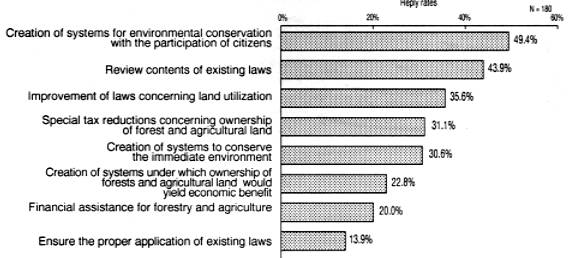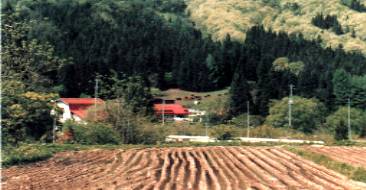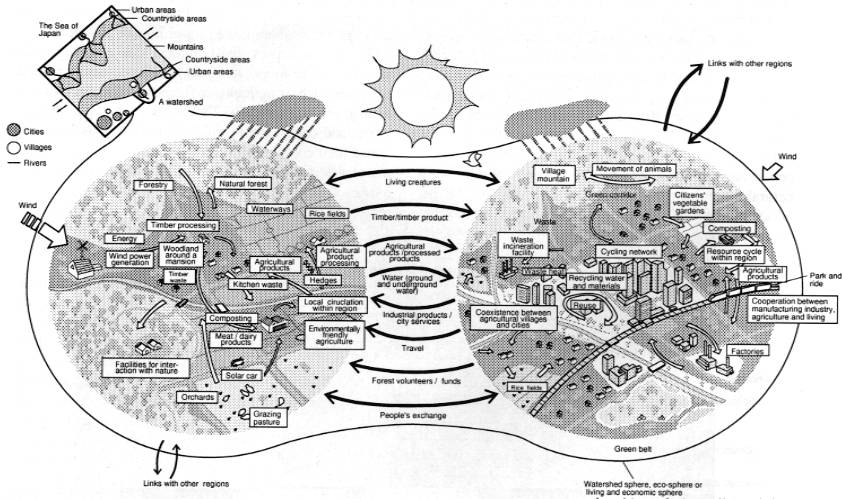Chapter II :Quality of the Environment in Japan 1998
Chapter II: Development of Local Communities with "Sound Material Cycle" and "Coexistence of Nature and Human Being", from the Viewpoint of Japan's Land Use
4. Ways to harmonize natural mechanisms and human activities
The following are measures for natural mechanisms and human activities.
Understanding of natural mechanisms
In today's society, where it has become hard to perceive natural mechanisms, it is first of all important to understand the interrelationship of nature's component parts and thus achieve an understanding of the mechanisms of nature. For this purpose it is important to see a whole area from the viewpoint of the spheres of environmental conservation such as eco-spheres and watershed spheres, and to ensure that various concerned parties in the area collaborate.
It is also necessary to present the mechanism of nature in some clear and understandable form. Mapping a nature area with special consideration paid to natural mechanisms is an effective measure for such presentation.
Adequate assessment of functions of natural mechanisms
In order to conserve the environment properly, it is necessary 1) to adequately assess the functions of the environment, and 2) to apply this adequate assessment to our actual economic activities. For example, an assessment was conducted using the CVM method of potential benefit assessment. Questionnaires asking how much they would pay concerning the value expected from recovering the ecosystem after demolishing two dams on the Elwha River on 2,500 households in the US. Those households expressed willingness to pay, on average, US$68 per annum per household for the recovery of the river's natural functions. This would realize a total of US$ 3-6 billion nationwide, an amount that far exceeded the cost of demolishing the dams. Due to dam construction the number of salmon and trout in the Elwha River had declined significantly and their extinction had been anticipated. In 1994 the decision was taken to demolish the dams.
Systems of human activities in harmony with natural mechanisms
It is important to develop systems wherein human activities occur based on understanding and function/ value assessments of natural mechanisms. Such systems may include elements of legislation established by the government administration as well as other systems reliant on the participation of the various sectors that go to make up society. A typical example of the legislative system by the government administration is the system of land utilization. The Japanese system of land utilization involves a number of different laws, and it is desirable to include sufficient viewpoints regarding environmental conservation in a legal system of this nature. Moreover, the participation of the different sectors that go to make up society is essential in order to carry out human activities in harmony with the mechanisms of nature. For this purpose it is very important to draw up guidelines and plans, to have some "places" for discussions and meetings such as watershed conference, and also to organize networks of local people to work together.
Environmental Conservation Tasks at the Regional Level
Source: Environment Agency
Expectations for "countryside areas"
The Basic Environment Plan defines countryside areas as areas where large proportions of secondary nature, such as copses, exist, middle-size and large-size animals can be found, and various human nature related activities such as agriculture, forestry and fisheries have formed the environment. This is the archetypal "hometown landscape" where wildlife and humans have retained their complex relationships. Countryside areas are places where the harmony of the natural mechanism and human activities can be realized most perfectly to promote community development and environmental conservation by making the most of local resources such as farm lands and copses.
However, the diverse natural environment of many countryside areas is being destroyed by road construction and the development of resort and residential areas. Due to the development of modern agricultural methods and the modern lifestyle, the circular system within rural regions is falling apart, the population is decreasing and the average age of villagers is increasing. Furthermore, agricultural lands and forests that remain in urban areas are decreasing.
Meanwhile, in large cities where environment and social security become worse with increasing population, many people hope to have more contact with nature and peace of mind. Thus in the cities the need for the archetypal hometown landscape is high and the collaboration between countryside areas and urban areas is becoming important.
It was to this background that, on 25th February 1998, the "Network For Sustainable Rural Communities" was established in cooperation between local governments, companies, universities/research institutes and citizens groups both in countryside areas and cities, aiming at community development of countryside areas of a kind that makes both environmental conservation and economic self-support compatible. Planned activities of the network include gathering and providing information on countryside areas coexistence projects, drawing up guidelines for such projects, and research work in pilot cases in some areas.

A typical countryside area landscape
Photo: Network for Sustainable Rural Communities (NSRC)
Adjustment of human activities in accordance with natural mechanisms (environmental impact assessment)
In June 1997 the Environmental Impact Assessment (EIA) Law was established. Key points in this law are 1) the introduction of a system designed to encourage opinions on assessment points, and research enabling EIA to be started at an early stage; and 2) expansion of the range of assessment to the whole area covered by the Basic Environment Law, as well as the introduction of the concept of reducing environmental impacts as much a s possible.
Strategic EIA is also under discussion mainly among developed countries as a method to include environmental concerns in the decision-making process of the government administration.
In Japan some local governments are also using, or are considering the introduction, of EIA at the planning stage of their public works projects.
Development of local communities aiming at "sound material cycle" and "coexistence of nature and human being"
As seen above, conceptualizing the land as various spheres and considering human activities based on the concept of these spheres is an effective measure for the preservation and conservation of a healthy environment as well as for the realization of wealthy human life. What is most important here is that all the relevant people, technologies, systems and measures work together. In other words, mutual respect and collaboration of "hard," "soft" and "heart" - "hard" technologies and social capital, "soft" systems and cultures, and "heart," which links human minds - are very important.
Community Building Aiming for
"Sound Material Cycles" and "Coexistence of Nature and Human Being"

In each living and economic sphere, the following points are realized in cooperation with other spheres. 1.Keep the history of coexistence of nature and human beings. 2.Appropriate introduction of local resource circularity within a region. 3.Cooperation and independence in local communities 4. Community development within human perspective.
Source: Environment Agency